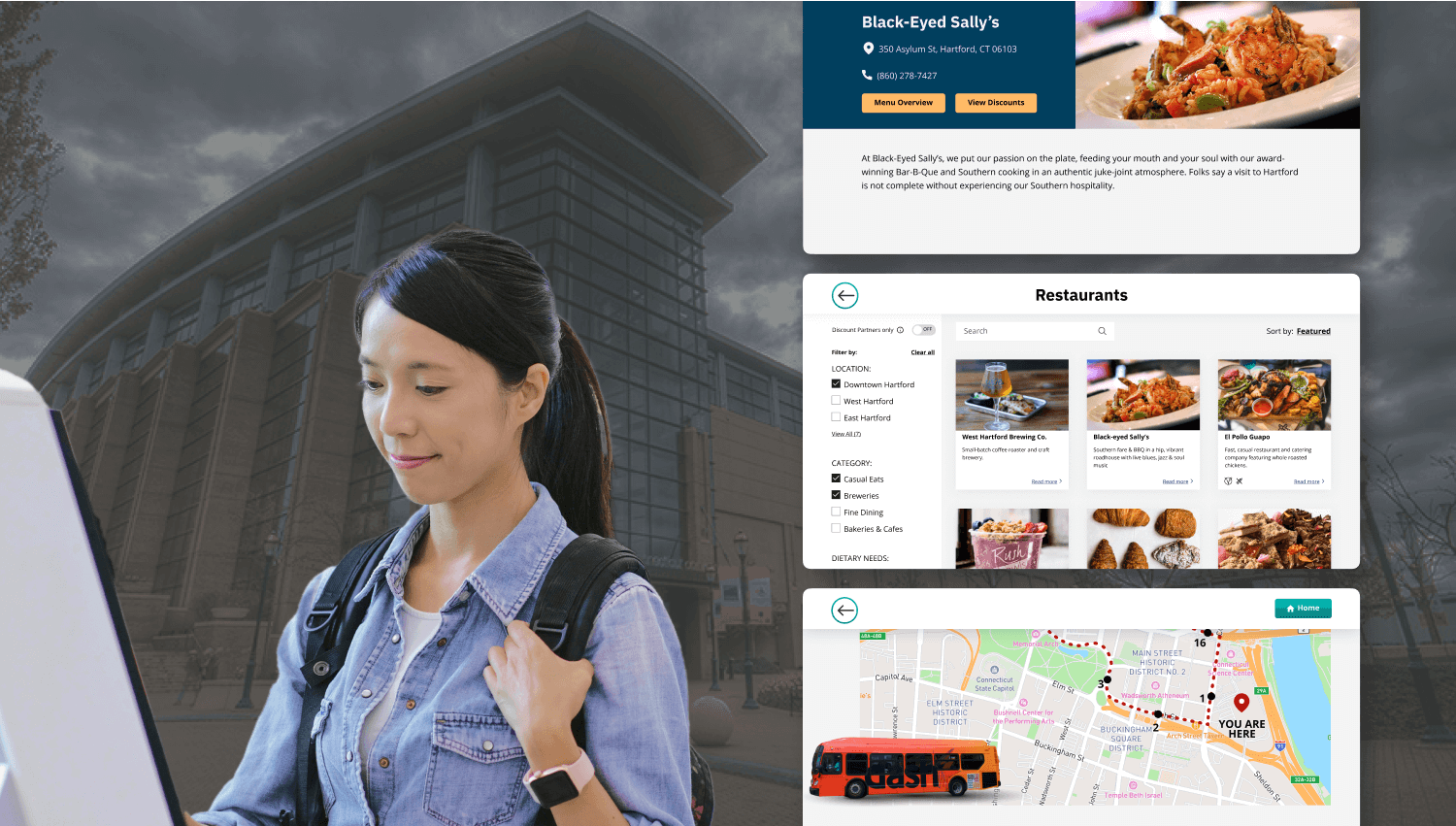
Timeline: April-June 2023
My Role: Product Design and Strategy
Company: Connecticut Convention Center
Project Type: TV screen and Mobile design
Changing How CTCC Guests Explore the City of Hartford
About the CTCC
The Connecticut Convention Center (CTCC) is a vast rental space owned by the State of Connecticut and located in Downtown Hartford.
Challenge
Design a strategy for connecting CTCC guests with local businesses to boost Hartford’s local economy using pre-purchased technology.
Result
Obtained an investment of over $60k for development of proposed solution.

PROJECT BACKGROUND
Setting the Scene
The Convention Center hired two Convention Service Managers (CSMs) whose primary goal for the year 2023 would be to connect the CTCC and its guests with local businesses by encouraging them to explore Hartford.
Original Solution
The CSMs planned to encourage exploration of Hartford by:
Setting up an exclusive discount program with Bandwango where guests have access to coupons for local restaurants and attractions on their phone.
Purchasing Touch Screen TVs to advertise the discount program, provide a space for guests to get the sign-up link for the discount program, and promote local businesses.
Complications
Several weeks after exploring the original solution, the CSMs discovered that:
Bandwango, a marketing platform, only facilitated the discount program. They DID NOT offer any user experience that would allow guests to sign up for the program.
The TVs DID NOT come with a pre-existing interface for guests to interact with.
The quick fix: Before I joined the project, a slide show of restaurants and other essential locations in the Hartford Downtown area were placed on the TVs. The slide show played in a loop with 8 seconds per slide.

90% of CTCC guests are not from Hartford
DEFINING A NEW STRATEGY
Understanding Our Guests
Through guerrilla research and first-hand knowledge, I discovered that the CTCC’s highest revenue/highest attendance events bring people from out of state and that:
Guests are unfamiliar with Hartford: Most guests are not from Hartford County and are often visiting from out-of-state if they come to the CTCC for larger, multi-day events.
Guests opt for food and activities within walking distance: Our free Downtown Shuttle (the DASH) remains mostly empty on event days and brochures featuring information about Hartford restaurants and attractions go unnoticed.
Images of the CTCC brochures tucked in the corner of the first floor lobby, often overlooked by guests.

…what if we created an informational kiosk?
Thinking Outside the Box
When I joined the project, the CSMs asked me to create a classic-looking website for the TV with the sole purpose of promoting their discount program and provided me with examples like Hartford.com.
Although tourist websites like Hartford.com are effective in their own use cases, I hypothesized that the TV interface would need to look and act different because of the size and context of the screens.
Aligning With People’s Mental Models
After conducting secondary research to understand user expectations with large screens in unfamiliar places, I reasoned that the TV screens should look more like a kiosk instead of a website to better align with mental models.
Kiosk brainstorming Figjam board.
Facilitating Stakeholder Workshops
I facilitated multiple meetings and workshops with the CSMs to make sure everyone was onboard with my ideas and ensure the project itself was a collaborative experience.
One of the key activities we did was Scenario Mapping. This exercise helped me:
Pitch the idea of creating a kiosk-like interface for the TVs that tells guests where to go, how to get there safely, and what discounts they have access to.
Show and explain the importance of empathy to my stakeholders and emphasize its importance in user experience design.
Encourage stakeholders to participate in identifying solutions, potential pain points, and consider how to address them.
Scenario mapping Figjam board.
Workshop Outcome: A holistic approach to design
While collaborating with the CSMs, we defined a new primary goal that would drive my design decisions:
Enhance the experience of CTCC guests who are unfamiliar with the Hartford area by enabling them to find their way around the city while providing context for local businesses and attractions and incentivizing them to visit via discounts offered by Bandwango.

“Something about calling it a ‘kiosk’ made it click for me.”
— Stakeholder

INITIAL CONCEPTS
Sketches
Early sketches were focused on figuring out the layout of different screens in service of the new primary goal of improving way finding and discoverability for CTCC guests while identifying logical touch points for promoting the discount program.
Exploring TV screen orientation and set up
Exploring the flow for selecting a restaurant and what these screens could look like
Exploring what the mobile version would look like and how users would get to the mobile screens
Designing for Restaurants
Because early launched discounts only involved restaurants, I primarily focused on the restaurant user flow creating initial designs.
At this time, we anticipated only putting the local restaurants that signed up to be part of the discount program on the kiosk.
User Task Flow: Selecting a Restaurant
I decided to embed the idea of discounts throughout the experience by:
Placing the Discounts button top center of the kiosk home screen so that it’s the first thing guests see when they approach the TV.
Adding a View Discounts button on each applicable overview screen.
The CSMs also planned to promote the discount program during events with banners, flyers, and word-of-mouth.
A Closer Look: Restaurant Overview Screen
To give guests the context they need to gain interest in the restaurant, get there safely, and learn about the discount program, I included the following elements on the Restaurant Overview kiosk screens:
Details about the restaurant
Discount information
Clear instructions on how to get to the restaurant and transportation recommendations (DASH, CT Transit bus, or Uber/car) determined by the CSMs
QR code placement that would open the mobile app version of the current screen for guests to reference on-the-go.

PRESENTATION & ITERATION
Stakeholder Presentation
After creating enough screens to illustrate my concept, I met with the CTCC’s upper management pitched my strategy for helping guests explore Hartford to the General Manager and Director of Sales.
Feedback
The GM and Director of Sales were more than supportive of the interface and excited about how it would help our guests.
The GM in particular was interested in how we might scale this solution, explaining that we would need the future ability to add all of Connecticut’s restaurants to the kiosk if they request to be there.

“Can we scale this to include all restaurants in CT?”
Designs 2.0
Based on direct feedback from the GM, I expanded on my original designs and created a sort and filtering system to help guests choose from far more than the 20 restaurants originally in scope for this project. I also added a search bar to help guests sift through what would (hopefully) one day be hundreds of restaurants.

CONCLUSION
Outcome
Over the course of 2 months, I was able to lay down the foundation for the CTCC’s first informational kiosk by:
Identifying an abandoned user experience and advocating for a solution that better serves CTCC guests
Teaching stakeholders about UX and the importance of user needs
Obtaining investment in my strategy by presenting the kiosk concept and clickable prototype to the General Manager and the Director of Sales
What happened next?
Due to the one month project timeline and lack of internal resources at the CTCC, I recommended the CSMs outsource the work to a local agency for implementation. The CSMs agreed and I helped them identify an agency best suited for the job.
After working with the agency for a few weeks, the CTCC decided to expand their timeline and as of September 2023, they’ve invested in higher quality hardware for the kiosks and are working on developing my strategy.
Takeaways
Throughout this unconventional design project, I discovered that being able to clearly articulate decisions is the key to making impactful changes within a business.
Due to general confusion about the technical aspects of this project from before I joined the team, I decided to prioritize pitching my designs and ideas in a way that would resonate with people from different backgrounds. A a result, I spent many hours on the presentations and materials I would use to ensure stakeholders understood the context, methods, and terminology needed for us to work together.
Teaching tech to a company without a tech department was a huge challenge, but in the end I was able to convince upper management to invest in creating a digital experience that will change how CTCC guests interact with the city of Hartford.







